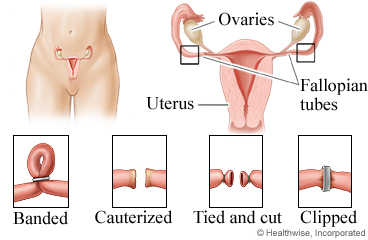
Your Care Instructions
If you don't want to get pregnant again, you can choose to have a tubal ligation after you give birth. This is called postpartum tubal ligation. Some people call it having the tubes tied.
Your doctor will band, burn (cauterize), tie and cut, clip, or remove your fallopian tubes. After this, an egg can't move down your tubes and can't be fertilized. This means you can't get pregnant.
If you have a vaginal birth, you can have this surgery 24 to 36 hours after the birth. If you have a cesarean birth, it can be done right after the birth, as part of the same surgery.
It is important to make sure that you want this surgery. This is because it is usually permanent. But in rare cases (about 20 out of 1,000 in 10 years), the surgery doesn't work, so you could get pregnant. If pregnancy occurs, you have an increased risk of having the fertilized egg grow outside of the uterus (ectopic pregnancy). An ectopic pregnancy never results in a normal pregnancy and birth. Ectopic pregnancy can cause life-threatening bleeding.
If you decide that you want to get pregnant again, it may be possible to put your tubes back together later. But you still may not be able to get pregnant. Putting your tubes back together is expensive. And insurance usually doesn't pay for it.
Follow-up care is a key part of your treatment and safety. Be sure to make and go to all appointments, and call your doctor if you are having problems. It's also a good idea to know your test results and keep a list of the medicines you take.
How is the surgery done?
You will get anesthesia. This is medicine to prevent pain during surgery.
If you have a vaginal birth, the doctor will make a small cut (incision) below your belly button. The doctor cuts and ties off the ends of the tubes. This can also be done during a cesarean birth.
You can also have tubal ligation later if you aren't sure that you want to do it now.
You may be able to go home the same day. The doctor will tell you what pain medicine to take. You will have a follow-up visit several weeks after surgery.
What are the risks of the surgery?
Tubal ligation is usually very safe. But all surgery has some risk. There is a very small risk of pregnancy, usually in the first year. This can happen if the tubes grow back together.
If the surgery doesn't work and you get pregnant, you have a greater chance of an ectopic pregnancy. This is a pregnancy that happens in the fallopian tubes and not in the uterus. Your risk for this is still very small. But this type of pregnancy is dangerous.
You have a very small risk of infection or bleeding. You also could have problems from the anesthesia.
When should you call for help?
Watch closely for changes in your health, and be sure to contact your doctor if:
- You want more information about this surgery.
- You want information about other forms of birth control.
Where can you learn more?
Go to http://www.healthwise.net/patientEd
Enter Z134 in the search box to learn more about "Postpartum Tubal Ligation: Care Instructions".
Current as of: November 27, 2023
Author: Healthwise Staff
Clinical Review Board
All Healthwise education is reviewed by a team that includes physicians, nurses, advanced practitioners, registered dieticians, and other healthcare professionals.

